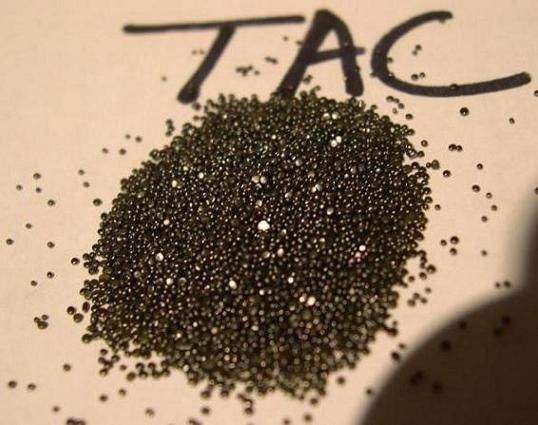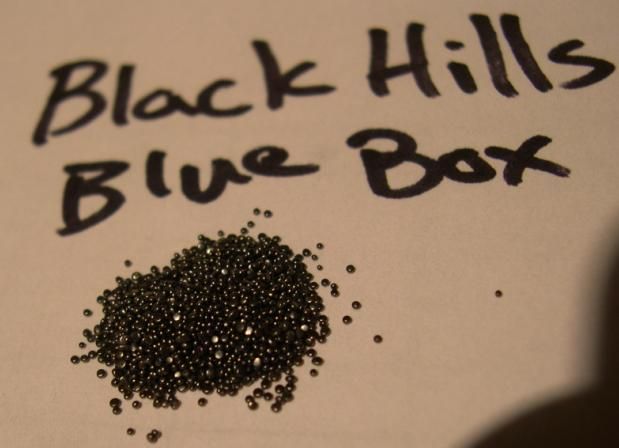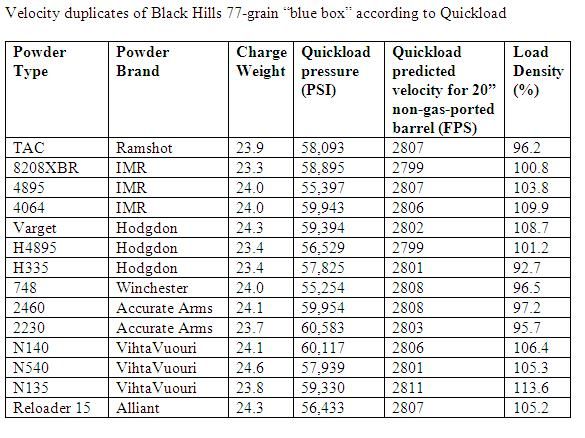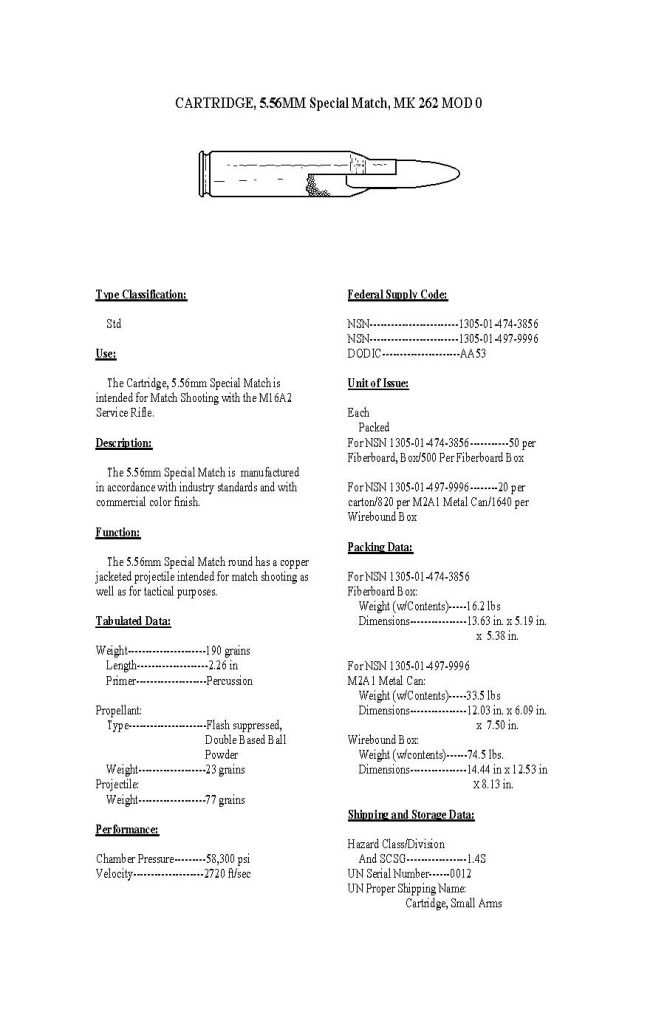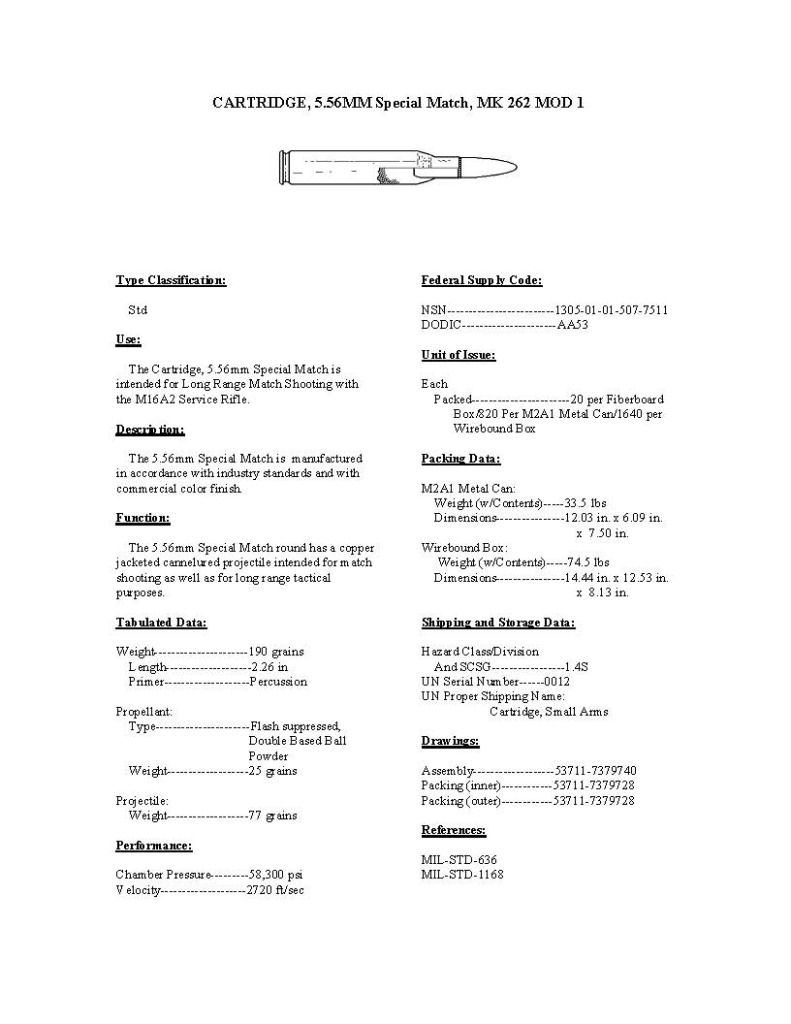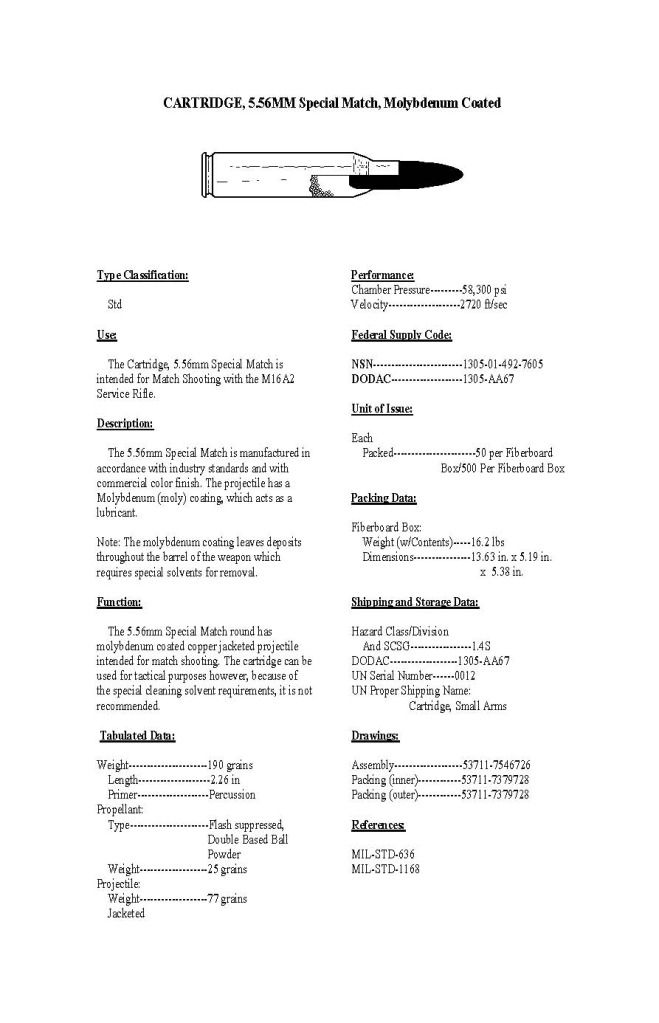Re: cloning MK262 ammo
Test:
Create a handload that duplicates Black Hills “Blue Box” 77-grain ammo.
RESULTS:
Short version:
23.9 grains Ramshot TAC and 77 SMK loaded to 2.250” (magazine length) duplicates velocity of Black Hills Blue Box.
This is a 97% density load (not compressed) – you can hear the powder rattle in a loaded round.
Keep reading if you want the long version.
Rifle used for test: AR-15 rifle with 20” barrel.
Chronograph used for test: Chrony Beta Master.
No software was used for velocity-estimation. All velocities reported here are actual shots fired over a chronograph.
I attempted to shoot 10-shot strings to gather the chronograph data.
You will notice that the data sets do not all contain 10 shots.
The Chrony chronograph sometimes simply failed to display the velocity.
It looks like 23.9 grains of TAC will get you the same velocity with the 77 SMK as the Black Hills “blue box.”
In case you are wondering “Why TAC powder?”
Here are the reasons:
1. There is ample internet rumor that Black Hills uses TAC for this load.
2. Pulled powder from an actual Black Hills load appears visually identical to the powder from an actual jug of TAC powder. In each case, the powder appears to be “flattened spheres” of varying size. Yes, I am aware that there are various gunpowders that have this appearance.
3. The weight of the powder charge removed from a round of Black Hills blue-box 77 grain ammo just happens to weigh 23.9 grains. (Given the vagaries of scale calibration, I will concede that the weight could be 23.8 or 24.0).
4. The chronographed average velocity of several rounds of Black Hills blue-box (2702 fps) just happens to fall right in between the chronographed average velocities of 23.8 grains of TAC (2693 fps) and 24.0 grains of TAC (2747 fps)respectively.
23.8 grains Ramshot TAC
77 SMK 2.250” (magazine length)
August 12, 2012
Ammo temperature approximately 75 degrees Farenheit
.
.
.
24.0 grains Ramshot TAC
77 SMK 2.250” (magazine length)
August 12, 2012
Ammo temperature approximately 75 degrees Farenheit
.
.
.
24.2 grains Ramshot TAC
77 SMK 2.250” (magazine length)
August 12, 2012
Ammo temperature approximately 75 degrees Farenheit
.
.
.
Black Hills “Blue Box”
77 SMK
December 26, 2011
ammo temperature approximately 90 degrees Fahrenheit
Lastly, you may be interested to know that the bullet I pulled from the Black Hills ammo has a cannelure, and obvious evidence of a circumferential crimp.
Velocity duplicates of Black Hills 77-grain “blue box” according to Quickload
(scroll down for chart)
Black Hills 77-grain “blue box” ammo consistently chronographs about 2710 fps through the rifle I use for all my AR15 ammo testing.
<span style="text-decoration: underline"><span style="font-weight: bold">Quickload</span></span>
These loads were determined by Quickload version 3.6.
http://www.neconos.com/details3.htm
Quickload is a fairly expensive computer program for reloaders.
Quickload has been around in various forms since 1987.
<span style="text-decoration: underline"><span style="font-weight: bold">Comparison history</span></span>
The only load listed here, and actually tested over a chronograph, is the load for TAC powder. For all intents and purposes, TAC provided a velocity identical to the velocity obtained from Black Hills “blue box” 77-grain ammo with the Sierra 77-grain MatchKing bullet. Moreover, the powder I inspected from an actual 77-grain “blue box” cartridge weighed exactly 23.9 grains, and had an appearance exactly like Ramshot TAC powder.
<span style="text-decoration: underline"><span style="font-weight: bold">Quickload consistently predicts about 90 FPS faster velocities than actually obtained over a chronograph.</span></span>
Based on my empirical testing of various loads over the chronograph, and comparing the chronographed velocities of those various loads, I have discovered that Quickload routinely predicts a velocity 80 to 100 feet per second faster than the velocity actually obtained by chronograph measurement when the ammo is fired in an AR15 type rifle. My theory for the consistent velocity discrepancy is that Quickload does not account for the loss of pressure due to gas escape through the AR15 gas port.
Black Hills 77-grain “blue box” ammo consistently chronographs about 2710 fps through the rifle I use for all my AR15 ammo testing. Similarly, 23.9 grains of TAC provides the same velocity with the same bullet. Quickload suggests that 23.9 grains should generate 2807 fps from an un-ported 20-inch barrel. Based on this consistent discrepancy, I have selected for my investigation, loads modeled by Quickload which also are predicted to be in the approximate 2800 fps range.
<span style="text-decoration: underline"><span style="font-weight: bold">Magazine-length dimensions</span></span>
All Quickload modeled loads assume bullet seated to 2.250” overall cartridge length.
SAAMI specification maximum length is 2.260”
I find that ammo loaded to SAAMI maximum length will sometimes be just a bit too long for AR15 magazines.
Ammo loaded to 2.250” or less never causes a feed-malfunction due to excess length.
<span style="text-decoration: underline"><span style="font-weight: bold">Pressure info</span></span>
The SAAMI industry specification for 5.56 NATO ammunition is 62,366 maximum PSI.
According to Quickload, all loads listed in the following chart fall below SAAMI maximum pressure, at 70 degrees temperature. This modeling exercise does not attempt to account for any variations which may occur due to temperature.
<span style="text-decoration: underline"><span style="font-weight: bold">Disclaimer</span></span>
This information is provided only for educational purposes. None of these loads are specifically recommended for any particular, or general, purpose. Persons using this information to construct live ammunition do so at their own risk, and with the understanding that this information may not be accurate, and that the result of use of this information may result in damage to property or injury to person.


